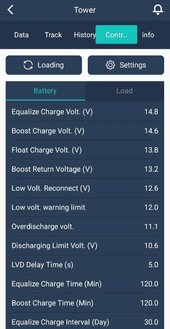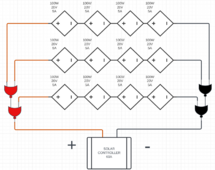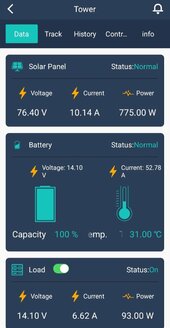Howdy! I'm new to the group. I have an off-grid 12V solar setup with 4 - 12V 8D FLA batteries in parallel with large bus bars. (approx. 606 Ah). The system load pulls 82-100W continuously 24 hours a day - 7 days a week. I am using a Renogy 60A SCC with 3 solar strings in a parallel-series config. Each string has 4 - 100W Renogy panels. During a full sun, crystal clear day the system sometimes produces over 800W with @ over 11A. Other full sun days will only produce 500W. Is this normal? I tested each string and each produces 80V as it should. I've also noticed that the battery voltage while charging never reaches more than 14.1V although boost charge is set to 14.6 Float charge is set to 13.8 but it seems to float(I think its floating) at 13.4. The boost time is set to 120 min. The R60 config is set to "USER". Each night the bank usually drains to 12.1. Some nights it plummets to 11.1 and the load auto kills until the morning. There seems to be a "hole" that the bank hits every once in a while. Do you think one or more batteries could be going bad? Batteries are 3 1/2 years old and are cycled in the manner described every single day. Should this bank of batteries be able to keep a better charge than this over night using 82-100W? The load wattage also seems to fluctuate depending on battery voltage. I use a DM1 4G data module to monitor remotely since the device is 1 hour away. Any insight on my solar and battery setup would be greatly appreciated. Thanks!
You are using an out of date browser. It may not display this or other websites correctly.
You should upgrade or use an alternative browser.
You should upgrade or use an alternative browser.
12V FLA Bank Not Full Charging?
- Thread starter Labpadre
- Start date
sunshine_eggo
Happy Breffast!
1200W on a 12V system requires:
1200W/14.4V = 83A of charge controller output.
Your 60A is limited to about 60A * 14.4V = 864W.
This is about right for a 600Ah battery - you want to charge at about 10% capacity.
Typical cause: You are using more energy daily than your system can provide. Stop using the batteries and allow them to come to full charge.
You could also have a single failed/marginal cell in one battery, which drains from the other parallel batteries.
You appear to have operated this way for some time. This means that the batteries have not been regularly fully charged and are likely severely degraded due to abuse.
~2kWh/day should be no issue with your setup
See lines 2 and 6 in my signature.
1200W/14.4V = 83A of charge controller output.
Your 60A is limited to about 60A * 14.4V = 864W.
This is about right for a 600Ah battery - you want to charge at about 10% capacity.
Typical cause: You are using more energy daily than your system can provide. Stop using the batteries and allow them to come to full charge.
You could also have a single failed/marginal cell in one battery, which drains from the other parallel batteries.
You appear to have operated this way for some time. This means that the batteries have not been regularly fully charged and are likely severely degraded due to abuse.
~2kWh/day should be no issue with your setup
See lines 2 and 6 in my signature.
Thanks for the speedy reply. You are correct. I have been operating like this for almost 4 years. Unfortunately, I cannot stop the load as it supplies a critical remote wifi and camera system. The data module does show that a full charge has completed about 75% of the time the system has been in use. When I anticipate very cloudy/rainy days I do run a generator and shore charger to compensate. My 3 string setup can only produce a max of 80V / 20A (only have ever seen 11A). Do you think an 6 string setup with 2 panels per string (40V / 30A) would be a better configuration?1200W on a 12V system requires:
1200W/14.4V = 83A of charge controller output.
Your 60A is limited to about 60A * 14.4V = 864W.
This is about right for a 600Ah battery - you want to charge at about 10% capacity.
Typical cause: You are using more energy daily than your system can provide. Stop using the batteries and allow them to come to full charge.
You could also have a single failed/marginal cell in one battery, which drains from the other parallel batteries.
You appear to have operated this way for some time. This means that the batteries have not been regularly fully charged and are likely severely degraded due to abuse.
~2kWh/day should be no issue with your setup
See lines 2 and 6 in my signature.
sunshine_eggo
Happy Breffast!
Thanks for the speedy reply. You are correct. I have been operating like this for almost 4 years. Unfortunately, I cannot stop the load as it supplies a critical remote wifi and camera system. The data module does show that a full charge has completed about 75% of the time the system has been in use.
Could I see these data?
Full charge would be hold 14.6V for a few hours or until charge current drops to 6-12A and then hold float voltage for the rest of the day.
When I anticipate very cloudy/rainy days I do run a generator and shore charger to compensate. My 3 string setup can only produce a max of 80V / 20A (only have ever seen 11A). Do you think an 6 string setup with 2 panels per string (40V / 30A) would be a better configuration?
Not at all. If all your panels and connections are good, you could do 12P, 2S6P, 3S4P, 4S3P with little difference in performance unless you have a long panel to MPPT run where the 4S3P would likely do best.
Remember a charge controllers rating is for amps OUTPUT. You could put 1000,0000000,00,0,0,0000,000W (commas intentionally misplaced to represent a ludicrous number) of PV on your controller, and you'd never get more than 864W out of it.
A 100W panel is only going to produce 100W when it's getting 1000W/m^2 of insolation. This would be at high noon, perfectly clear skies, with the panel tilted perfectly perpendicular to the sun, AND when it's also notably cooler than 25°C (the panel needs to be at 25°C). You lose 10% in perfect conditions simply because the cells are hotter than ambient.
If you want to improve the utilization of what you have, buy a 30A controller and split off a 4S string to that controller. That would allow you to fully utilize your 1200W of panels rather than just ~800W.
The full charge data is just the number of days in operation vs how many times a full charge was supposedly achieved. As I mentioned, I never see 14.6V (14.1V max). But after a few hours of 40-50A charge it does taper down to around 10A @ 13.5V for the rest of the day. Max amperage happens well before high noon. All panels are at 0° during the summer. and 10-15° in the winter.
Interesting idea to use another controller with one of the strings. How would I use them in tandem? Connect both controller's batt terminals to the battery bank? Or is there another way to connect the controllers together?
Interesting idea to use another controller with one of the strings. How would I use them in tandem? Connect both controller's batt terminals to the battery bank? Or is there another way to connect the controllers together?
sunshine_eggo
Happy Breffast!
The full charge data is just the number of days in operation vs how many times a full charge was supposedly achieved. As I mentioned, I never see 14.6V (14.1V max). But after a few hours of 40-50A charge it does taper down to around 10A @ 13.5V for the rest of the day. Max amperage happens well before high noon. All panels are at 0° during the summer. and 10-15° in the winter.
You either have a measurement error, wiring/sensing fault or a faulty charger.
The fact that you never see 14.6V means the charger is only charging to 14.1V. Time spent charging at a lower voltage must be longer, sometimes notably so, than at higher voltage.
What is reporting 14.1V?
The next time you're on site, I would take voltage readings at noon and record the following as close to the same time as possible:
- Voltmeter on battery terminals:
- Voltmeter on MPPT's battery terminals:
- MPPT reported voltage:
- MPPT reported current:
Interesting idea to use another controller with one of the strings.
Astoundingly common and unremarkable configuration.
How would I use them in tandem? Connect both controller's batt terminals to the battery bank? Or is there another way to connect the controllers together?
You would install them as you would as if the other doesn't exist. Some controllers have means of coordinating their charge efforts, but most don't. Even when they do, there is little advantage to doing so.

Charging from multiple sources
One can have as many independent charging sources running concurrently as they like provided they are programmed properly for the voltage of one's battery bank. Examples (some or all at once, even multiples of a single type, different brands, etc.): Solar PV via MPPT Solar PV via PWM AC-DC...
R60 SCC via 4G data module is what's reporting all data. Attached is a screenshot at 10:17 am showing 775W @10A and 14.1V @ 52A to the battery bank. Looking through other screenshots I just noticed there have been times where 14.3V pops up.You either have a measurement error, wiring/sensing fault or a faulty charger.
The fact that you never see 14.6V means the charger is only charging to 14.1V. Time spent charging at a lower voltage must be longer, sometimes notably so, than at higher voltage.
What is reporting 14.1V?
The next time you're on site, I would take voltage readings at noon and record the following as close to the same time as possible:
- Voltmeter on battery terminals:
- Voltmeter on MPPT's battery terminals:
- MPPT reported voltage:
- MPPT reported current:
Astoundingly common and unremarkable configuration.
You would install them as you would as if the other doesn't exist. Some controllers have means of coordinating their charge efforts, but most don't. Even when they do, there is little advantage to doing so.

Charging from multiple sources
One can have as many independent charging sources running concurrently as they like provided they are programmed properly for the voltage of one's battery bank. Examples (some or all at once, even multiples of a single type, different brands, etc.): Solar PV via MPPT Solar PV via PWM AC-DC...diysolarforum.com
I will take reading as you suggested on my next trip out.
"Attaching both SCC to the battery bank as if the other did not exist"...wouldn't one interpret the other as possibly the battery not needing as much of a charge because it's sensing the other's voltage? Like putting to shore chargers together...one would seem to negate the other. I do have a wind turbine that I want to add to my setup for supplemental power. I assume I would install in the same manner as you suggested.
Attachments
sunshine_eggo
Happy Breffast!
R60 SCC via 4G data module is what's reporting all data. Attached is a screenshot at 10:17 am showing 775W @10A and 14.1V @ 52A to the battery bank. Looking through other screenshots I just noticed there have been times where 14.3V pops up.
Normal charging stages:
- Bulk - max available current to bulk/boost/absorption voltage, 14.6V.
- Absorption - hold 14.6V while current tapers to 0.01-0.03C over the course of hours (most lead acid batteries are fully charged at this point).
- Float - hold battery float voltage
This is also supported by the fact that you attained 14.3V on one occasion.
Something else to note... lead acid charging is notably inefficient especially at higher states of charge (absorption). If you use 100Ah out of them, you need to put in 115Ah (15%) to get back to full charge.
I will take reading as you suggested on my next trip out.
That will help to establish if you have any connection or sensing issues.
"Attaching both SCC to the battery bank as if the other did not exist"...wouldn't one interpret the other as possibly the battery not needing as much of a charge because it's sensing the other's voltage? Like putting to shore chargers together...one would seem to negate the other. I do have a wind turbine that I want to add to my setup for supplemental power. I assume I would install in the same manner as you suggested.
How is a 60A charger and a 30A charger connected to the same battery different than a single 90A charger?
Mostly they're not. In both cases, there is 90A going into the battery, and there is a voltage increase consistent with that 90A input.
From:

Charging from multiple sources
One can have as many independent charging sources running concurrently as they like provided they are programmed properly for the voltage of one's battery bank. Examples (some or all at once, even multiples of a single type, different brands, etc.): Solar PV via MPPT Solar PV via PWM AC-DC...
Note:
Multiple chargers only offer benefit when the battery is below the absorption voltage. Once the absorption voltage is hit, it is now a voltage limited charge and thus current will be lower than the sum of all sources. The battery bank will only accept as much current as it needs to maintain the absorption voltage. As the battery bank fills, current is reduced and chargers can no longer deliver current at the absorption voltage. They will drop out and go to float. Typically, the highest current charging source will always be the last source charging while all others are at 0A and likely in float mode.
I was just thinking on a literal level. If one charger is producing 14.1V its seems that the second charger would assume the battery voltage is 14.1V and quit charging. It seems that I have experienced this before when I ran the generator and shore charger while the sun was still producing decent power. After a few minutes the solar power decreased dramatically as the shore charger took full duty.How is a 60A charger and a 30A charger connected to the same battery different than a single 90A charger?
sunshine_eggo
Happy Breffast!
I was just thinking on a literal level. If one charger is producing 14.1V its seems that the second charger would assume the battery voltage is 14.1V and quit charging. It seems that I have experienced this before when I ran the generator and shore charger while the sun was still producing decent power. After a few minutes the solar power decreased dramatically as the shore charger took full duty.
The chargers will be at (well, a little above) the battery voltage. You can't have a battery at 13.8V, a charger at 14.1V and another charger at 14.2V.
Both chargers may be SET for 14.1V, but both chargers are just over 13.8V in order for current to flow to the battery. The chargers aren't pushing current, the battery bank is pulling current and is a load to the chargers.
Example: Lead acid battery has a 4mΩ resistance, and you have 50A going into a battery at 13.9V:
V = I * R
V = 50 * .004 = 0.2V
Thus your charger would be at 14.1V.
Now the charger, if set to 14.1V, can't rise above this, so the battery draws less current as it fills. If the current drops to 25A, and the charger is at 14.1V, the battery would be at 25A * .004 = 0.1V or 0.1V below the charger voltage, 14.0V. So you can see that as the battery fills, and it's voltage increases, the current naturally tapers.
This exercise ignores any voltage drop due to wiring losses.
What you're observing is that your AC charger is so much stronger than your PV charger, the battery voltage increases to absorption, and the battery can't accept both what the AC charger and PV chargers can provide at the set voltage, so the weaker charger falls out. Again, the statement:
Note:
Multiple chargers only offer benefit when the battery is below the absorption voltage. Once the absorption voltage is hit, it is now a voltage limited charge and thus current will be lower than the sum of all sources. The battery bank will only accept as much current as it needs to maintain the absorption voltage. As the battery bank fills, current is reduced and chargers can no longer deliver current at the absorption voltage. They will drop out and go to float. Typically, the highest current charging source will always be the last source charging while all others are at 0A and likely in float mode.
Similar threads
- Replies
- 14
- Views
- 393
- Replies
- 1
- Views
- 268
- Replies
- 1
- Views
- 166
- Replies
- 7
- Views
- 515





